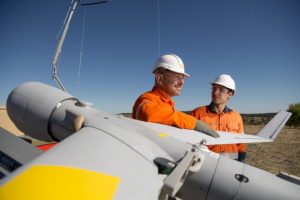 The Australian state of Queensland is partnering with one of the world’s largest oil companies to inspect natural gas wells with drones.
The Australian state of Queensland is partnering with one of the world’s largest oil companies to inspect natural gas wells with drones.
Queensland Premier Annastacia Palaszczuk announced a $1 million agreement with Shell-owned Queensland Gas Company to launch an inspection drone program that is expected to save millions of dollars by decreasing manned, ground-vehicle inspections.
The Advance Queensland project will deploy beyond-line-of-site, fixed-wing drones that will carry several sensor packages to check for natural-gas leaks and infrastructure conditions. The system will also keep track of other aircraft in the area to avoid collisions.
“The Advance Queensland research funding is a welcome boost to adoption of remotely piloted aircraft systems and importantly, a shot in the arm for the sector-at-large,” Queensland Resources Council Chief Executive Michael Roche said in a press release.
The project funding will develop testing for more industrial-sector drone use across the energy and mining sectors. The inspection drones will be operated by Insitu Pacific, a subsidiary of Boeing. The aircraft will sport a ten-foot wingspan and can fly up to 2,000 feet.
“The project aims to capitalize on the capabilities inherent in drones to carry out remote monitoring and inspection of key infrastructure and data analysis to allow for better decision-making,” Palaszczuk said.
“Landowners will benefit, over time, from fewer visits to their properties while QGC and the community will benefit from fewer vehicles on the roads,” Shell’s Vice President QGC Tony Nunan said in a statement.
Australia joins one of many industrialized nations to expand UAV adoption in inspection and mining industries. Last year, Rio Tinto — a British-Australian multinational — is using drones to monitor its coal and iron ore facilities in Western Australia and Queensland.
Deploying a combination of fixed-wing and rotary UAVs equipped with video, infrared and other sensor arrays, the company can survey stockpile inventory, perform remote survey work, monitor wall movements in mines and inspect various infrastructure lines.
Source link
 Unmanned Aerial Vehicle The latest drone news
Unmanned Aerial Vehicle The latest drone news



